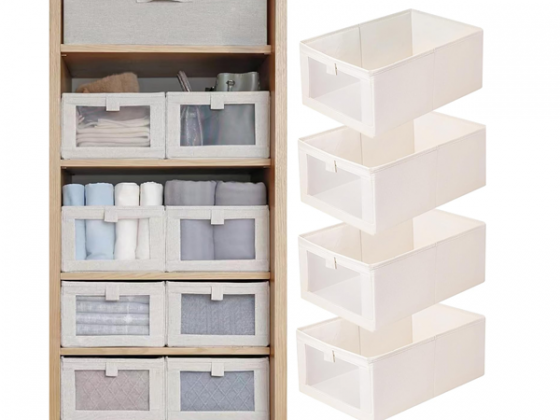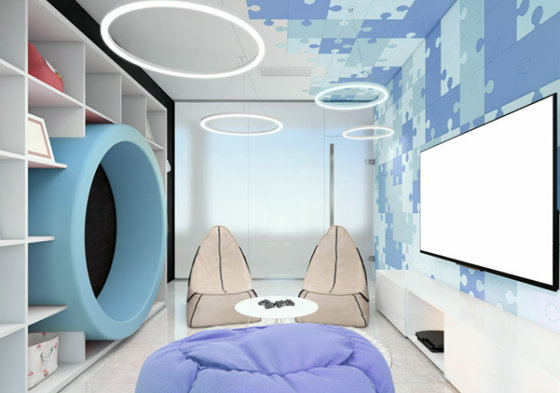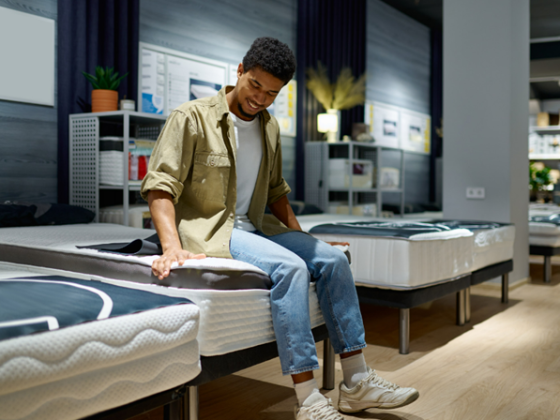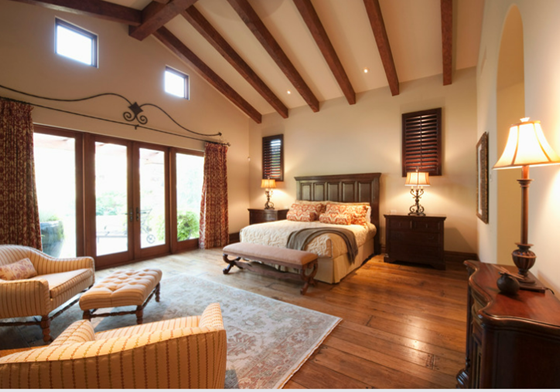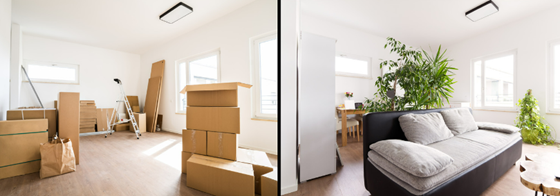Spanish interior design is a captivating blend of influences from its Mediterranean neighbors. With elements reminiscent of French country, Tuscan, and Moroccan styles, Spanish homes possess a distinctive and charming character. If you’re drawn to warm color palettes, vibrant terracotta hues, captivating ceramics, and rustic textures, Spanish interior design might be the perfect choice for your home.
The Essence of Spanish Style
Spanish design is synonymous with its Mediterranean roots. Its colors, reminiscent of the coastline, include tranquil blues and greens, complemented by the warmth of terracotta and rich earthy tones. The extensive use of terracotta tiles in flooring and roofing contributes to the distinct Spanish color scheme. Spanish interiors are adorned with stone, ceramics, pottery, wrought iron, candle holders, and carved wooden panels. Copper accents are a staple in this style.
Decorative Walls: Heavy-textured wall finishes, created with stucco or plaster, add visual depth. Soft neutral glazes often accompany these textured walls for more definition and color. Spanish wall décor usually includes rich woven tapestries and wrought iron grilles for a rustic, elegant touch. Accessories are kept to a minimum, focusing on a few larger items like urns, vases, planters, and pots.
Spanish Colonial Charm
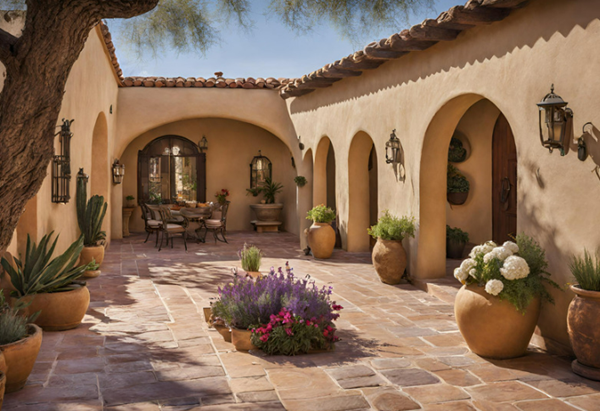
In the southwestern United States, the fusion of early Spanish colonial influence with Native American culture gave rise to the Spanish Colonial style. Often referred to as mission style, this design is deeply rooted in the historic mission churches of the region. Spanish Colonial homes are characterized by courtyards, tile rooftops, arches, and smooth stucco walls. The Southwestern landscape inspires a color palette of beige, deep yellow, red, purple, pink, and white.
Furniture and Accessories: Furniture and accessories in Spanish Colonial homes reflect simplicity and earthiness. Furniture is crafted from solid woods like oak, boasting sturdy designs with minimal ornamentation. Visible square dowels are a signature of the rustic style. The presence of built-in wall benches, free-standing cabinets, and bell-shaped corner fireplaces lends a unique touch. Floors are adorned with tiles made from stone, rock, or ceramic. Common accessories include pottery, metal accents, stained glass, and woven wall hangings. Carved wooden or painted images of saints are also cherished elements.
The Spanish Revival Era

In the 1920s, a surge in tourism to southern Spain inspired the construction of Spanish Revival homes in California. These homes showcased elements such as adobe bricks, stucco walls, terracotta roofs, wooden ceiling beams, shutters, and carved entry doors. Notably, wrought iron was prominently featured in gates, railings, banisters, and window grilles.
Furniture and Tiles: Spanish Revival interiors were often adorned with original pieces imported from Spain or commissioned furniture from local artisans. Furniture, typically crafted from oak or pine, boasted intricate details such as inlays, carvings, or painted finishes. The integration of leather and nail head trim created remarkable pieces. The era also marked the creation of exquisite decorative tiles, influenced by Spanish Catalina and traditional designs. These hand-painted tiles showcased distinctive textures combining matte and gloss finishes, yielding captivating, colorful patterns.
Infusing Spanish Style into Your Home
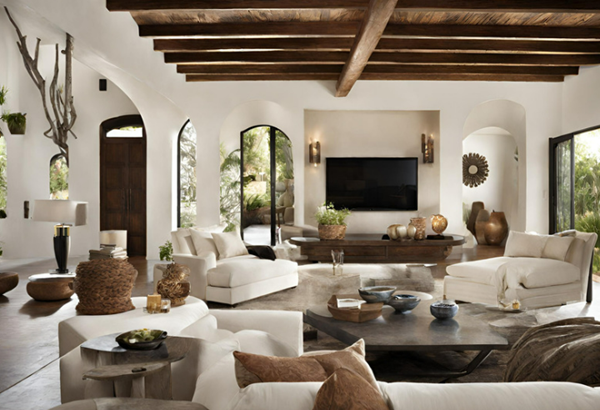
Whether you aim to embrace Spanish design entirely or simply wish to incorporate a few elements into your existing décor, there are numerous ways to infuse your space with a Spanish aesthetic.
Enhancing Walls: Achieve the textured look of stucco walls, accompanied by warm-toned finishes like off white, apricot, burnt sienna, or gold. Dark woodwork, trim, or moldings offer a striking contrast against these warm hues, providing depth to your living space.
Railing and Stairs: Replace solid wood banisters with wrought iron, a quintessential element of Spanish design. For a unique touch, consider hand-painted terracotta tiles on the risers of bare or uncarpeted stairs, adding a splash of vibrant colors.
Flooring: Opt for natural wood or tile floors, leaving them bare and adding textured throw rugs that mirror the room’s color palette.
Ceilings: Exposed wooden beams are a defining feature of Spanish interiors. If your ceilings allow, consider adding faux wood beams in a dark wood finish to create visual interest and provide a sense of gravity to the space.
Accentuate with Details: Adorn your space with essential Spanish design accents, including:
- Terracotta pottery
- Hand-glazed tiles on the kitchen backsplash and around the fireplace
- Wrought iron sconces and chandeliers
- Sturdy, hand-carved furniture pieces like armoires, sideboards, dressers, and dining room tables
- Stained glass windows
- Intricate-cut steel lampshades and accents
- Robust iron cabinet hardware and door handles
Create Your Unique Style
Spanish interior design offers a wealth of options to create a rich, warm, and captivating atmosphere. Whether you wish to embrace this style entirely or incorporate its elements into your existing décor, Spanish design can be adapted to enrich any space. By thoughtfully merging it with your home’s unique characteristics, you’ll create a distinctive atmosphere that exudes warmth and character.
Where to Find Spanish-Style Furniture and Decor:
- Spanish Colonial Furniture: Offers a wide range of Spanish-style furniture and decor.
- Etsy – Spanish Decor: Browse unique handmade Spanish-inspired decor items.
- La Fuente Imports: Specializes in Mexican and Southwest-style furniture and decor.
- Wayfair – Spanish Style Furniture: Offers a variety of Spanish-inspired furniture and decor options.
Infuse your home with the richness and character of Spanish design by exploring these sources for Spanish style furniture and decor. Whether you’re seeking unique handmade pieces or furniture from specialized retailers, you’ll find a range of options to fit your style and budget.
